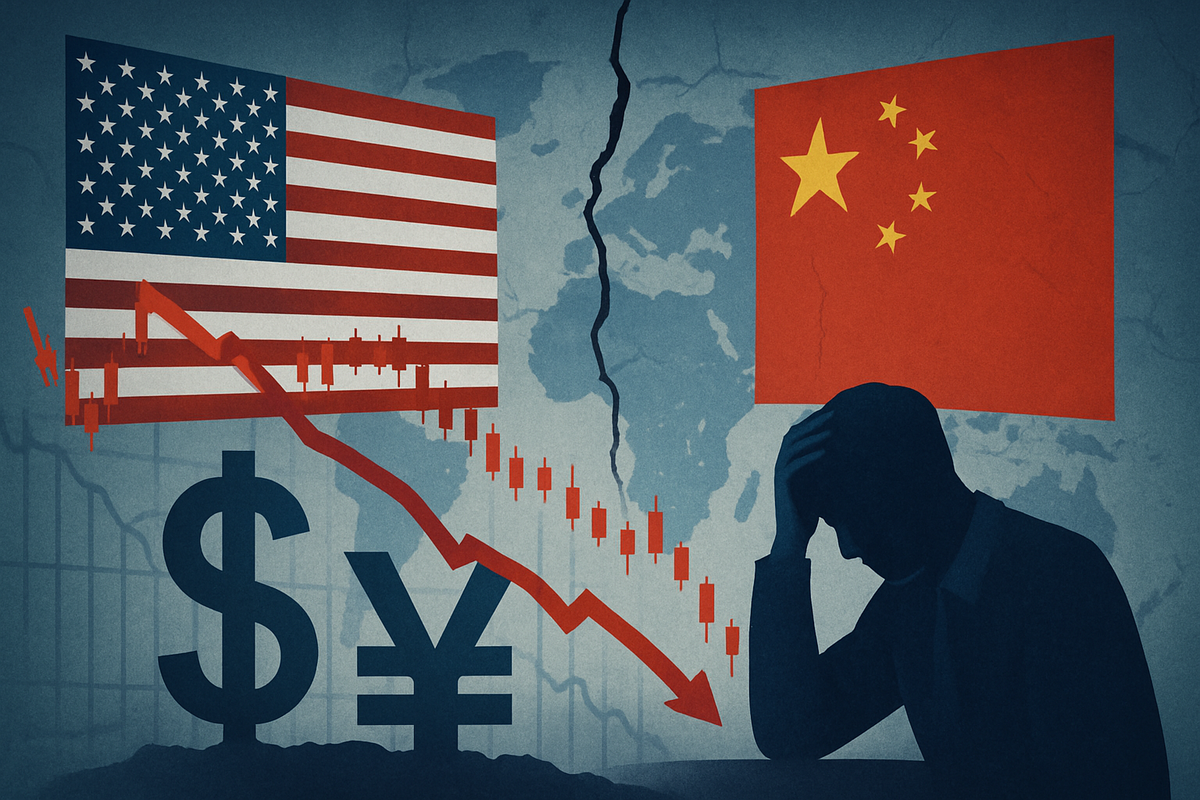
Global financial markets are reeling this week, specifically between October 10 and 12, 2025, as a renewed and aggressive escalation in the US-China trade war sends shockwaves across economies. President Donald Trump's recent threat to impose a staggering 100% tariff on Chinese goods, coupled with export controls on critical software, has been met with a defiant warning of retaliation from Beijing. This dramatic turn of events, unfolding over the past few days, has plunged investors into a state of heightened uncertainty, fearing a full-blown trade conflict with far-reaching consequences for global supply chains, corporate earnings, and economic stability.
The immediate fallout has been palpable, with U.S. equity markets experiencing their steepest declines in months, safe-haven assets surging, and the cryptocurrency market facing unprecedented volatility. As China’s Ministry of Commerce declared its readiness to "resolutely take corresponding measures" if the U.S. proceeds, the specter of a prolonged and damaging economic confrontation looms large. Investors are now grappling with the potential for disrupted negotiations, inflationary pressures, and a significant slowdown in global growth, all while navigating an already complex economic landscape.
Trade Tensions Ignite: A Weekend of Warnings and Market Panic
The latest chapter in the tumultuous US-China trade relationship began on Friday, October 10, 2025, when President Trump announced his administration's intention to levy an additional 100% tariff on Chinese imports, effective November 1. These tariffs, if implemented, would stack on top of existing duties, potentially pushing total import taxes on some goods to an astonishing 130% or even 145%. Concurrently, the President signaled a move towards export controls on "any and all critical software" originating from the US. This aggressive posture was framed as a direct response to China's recent restrictions on the export of rare earth elements, materials crucial for advanced technologies.
The global markets reacted swiftly and negatively to Trump's initial announcement on Friday. The S&P 500 (INDEXSP:.INX) plunged 2.7%, marking its steepest single-day drop since April 2025. The technology-heavy Nasdaq Composite (INDEXNASDAQ: .IXIC) suffered an even sharper decline of 3.6%, wiping out billions in market value and registering its largest single-day percentage drop since April. The Dow Jones Industrial Average (INDEXDJX:.DJI) also fell 1.9%. Technology giants such as Nvidia (NASDAQ: NVDA), Tesla (NASDAQ: TSLA), and Amazon.com (NASDAQ: AMZN) saw their shares tumble, with some tech stocks experiencing double-digit percentage drops. Chinese stocks listed in the U.S. also plummeted over 6%.
Over the weekend, on Sunday, October 12, 2025, China's Ministry of Commerce issued a forceful and unequivocal response. While stating that China "does not want a tariff war, it is not afraid of one," the ministry warned that it would "resolutely take corresponding measures to safeguard its legitimate rights and interests" should the U.S. proceed with the tariffs. Beijing also hinted at potential non-tariff countermeasures, including the imposition of special port fees on US-built and operated ships. China maintained that its rare earth export restrictions were legitimate security measures, not retaliatory actions, and urged the U.S. to seek negotiated solutions rather than resorting to threats.
The immediate concerns for investors are manifold. The primary fear is the full-blown escalation of the US-China trade war, which threatens to derail ongoing trade negotiations and a planned meeting between President Trump and Chinese leader Xi Jinping. This escalation promises significant disruptions to global supply chains, particularly within the technology and manufacturing sectors, due to tariffs and potential export controls on critical materials and software. Furthermore, investors are bracing for impacts on corporate margins and earnings, inflationary pressures, and a substantial drag on global economic growth, with some analysts even warning of a potential slide towards recession. The unexpected and aggressive nature of these announcements has significantly heightened market volatility, especially given already elevated equity valuations.
Companies on the Brink: Winners and Losers in the Escalating Trade War
The escalating trade tensions between the United States and China, particularly President Trump's threat of 100% tariffs and export controls, are poised to create a distinct landscape of winners and losers across various industries. Companies with significant exposure to cross-border supply chains, particularly those relying on Chinese manufacturing or U.S. technology, face immediate and severe risks. Conversely, some domestic producers or companies with diversified supply chains might find unexpected opportunities.
Among the most vulnerable are U.S. technology companies heavily reliant on Chinese manufacturing for components or assembly, or those with substantial sales in the Chinese market. Firms like Apple (NASDAQ: AAPL), which manufactures a significant portion of its products in China, could see production costs skyrocket and profit margins squeezed. Similarly, semiconductor companies such as Qualcomm (NASDAQ: QCOM) and Intel (NASDAQ: INTC), which supply critical components to Chinese tech giants, face the dual threat of retaliatory tariffs on their products entering China and potential export restrictions on their technology. The proposed export controls on "critical software" could severely impact U.S. software providers with Chinese clientele or manufacturing partners.
Conversely, some U.S. domestic manufacturers might see a short-term benefit as tariffs make Chinese imports less competitive. Industries like steel, aluminum, and certain consumer goods could experience a boost in demand for domestically produced alternatives. However, this benefit is often offset by higher input costs if those domestic manufacturers still rely on imported components, or by reduced consumer purchasing power due to overall price increases. Companies with highly diversified global supply chains, or those that have proactively shifted production out of China, such as some smaller electronics manufacturers, might be better positioned to weather the storm.
On the Chinese side, export-oriented manufacturers are directly in the crosshairs. Companies that produce goods for the U.S. market, from textiles and electronics to machinery, will see their products become prohibitively expensive for American consumers. This could lead to significant reductions in orders, factory closures, and job losses. Furthermore, the threat of export controls on critical software could severely hamper the growth and operational capabilities of Chinese technology companies like Huawei (SHE: 002502) and Tencent (HKG: 0700), which depend on U.S. software and intellectual property for their development and global competitiveness.
However, certain Chinese domestic industries could see increased government support and a push for self-reliance, particularly in strategic sectors. The rare earth minerals industry, for example, could leverage its near-monopoly to exert pressure and potentially benefit from increased global demand for non-Chinese sources or higher prices. Additionally, Chinese companies focused on domestic consumption or those with strong ties to Belt and Road Initiative countries might be more insulated from the immediate impact of U.S. tariffs. The broader implication is a forced decoupling, pushing both economies to seek alternatives and strengthen domestic capabilities, which could be a long-term boon for some localized industries but a significant challenge for those deeply integrated into the global economy.
Wider Significance: A New Era of Economic Nationalism and Supply Chain Re-evaluation
The current escalation in US-China trade tensions, marked by President Trump's 100% tariff threat and Beijing's vow of retaliation, transcends a mere economic dispute; it signals a deepening entrenchment of economic nationalism and a fundamental re-evaluation of global supply chains. This event is not an isolated incident but rather fits into a broader, ongoing trend of geopolitical competition where economic tools are increasingly wielded as strategic weapons. The aggressive use of tariffs and export controls underscores a global shift away from unfettered globalization towards a more protectionist and bifurcated economic order.
The potential ripple effects on competitors and partners are immense. For other major economies like the European Union, Japan, and South Korea, this trade war escalation presents a precarious tightrope walk. They face pressure to align with either the U.S. or China, while simultaneously striving to protect their own economic interests. Companies operating in these nations, particularly those with complex supply chains spanning both the U.S. and China, will be forced to make difficult strategic decisions, potentially leading to costly re-shoring or diversification efforts. This could accelerate the trend of "friend-shoring" or "near-shoring," where companies prioritize supply chain resilience and geopolitical alignment over pure cost efficiency.
Regulatory and policy implications are also significant. Beyond tariffs, the threat of export controls on "critical software" points to a broader push by the U.S. to restrict China's access to advanced technology, mirroring previous actions against specific Chinese tech firms. This could lead to a proliferation of similar technology-control regimes globally, fragmenting the digital economy and creating new barriers to innovation and trade. Beijing's potential non-tariff countermeasures, such as special port fees or increased regulatory scrutiny on U.S. companies operating in China, would further complicate the operating environment for multinational corporations. This era demands that businesses engage more deeply with geopolitical risk assessment and regulatory compliance.
Historically, this event draws comparisons to past trade disputes, but its scale and the strategic nature of the targeted sectors (e.g., rare earths, critical software) elevate its significance. While the 1930s Smoot-Hawley Tariff Act serves as a cautionary tale of protectionism exacerbating a global depression, the current situation is distinct due to the interconnectedness of modern supply chains and the weaponization of technology. More recently, the initial phases of the US-China trade war under the Trump administration (2018-2020) demonstrated the capacity for tit-for-tat tariffs to disrupt markets and slow global growth. However, the proposed 100% tariff marks a dramatic escalation beyond those initial rounds, signaling a potential move towards economic decoupling rather than mere negotiation leverage. This event underscores a fundamental shift in international relations, where economic interdependence is increasingly viewed as a vulnerability rather than a source of stability.
What Comes Next: Navigating a Fractured Global Economy
The immediate aftermath of China's retaliation warning and President Trump's 100% tariff threat points to a period of intense volatility and strategic re-evaluation for businesses and investors alike. In the short term, markets will likely remain highly sensitive to any further rhetoric or policy announcements from Washington or Beijing. The planned meeting between President Trump and Chinese leader Xi Jinping, if it proceeds, will be under immense scrutiny, with its outcome dictating whether the situation de-escalates or spirals further. Companies are already scrambling to assess the direct impact of the proposed tariffs on their import/export costs and to explore alternative sourcing or market strategies. Expect increased hedging activities and a continued flight to safe-haven assets as uncertainty persists.
Looking further ahead, the long-term possibilities suggest a more fractured global economy. Should these tariffs and export controls be fully implemented and China retaliate in kind, both nations, and by extension the global economy, will be forced into a period of significant strategic pivots. For the U.S., this could mean an accelerated push towards domestic manufacturing and technological independence, potentially through subsidies or incentives for reshoring. For China, it reinforces the imperative to achieve self-sufficiency in critical technologies, fostering indigenous innovation and reducing reliance on foreign components and software. This could lead to the emergence of distinct technological ecosystems, limiting cross-border collaboration and standard-setting.
Market opportunities and challenges will emerge from this strategic realignment. While companies deeply embedded in the existing U.S.-China supply chain face severe challenges, new opportunities may arise for businesses capable of facilitating supply chain diversification, offering alternative manufacturing solutions in other countries, or specializing in domestic production. For instance, countries in Southeast Asia, Mexico, or Eastern Europe could see increased investment as companies seek to de-risk their operations from the U.S.-China dynamic. Furthermore, industries focused on domestic consumption within either the U.S. or China might prove more resilient.
Potential scenarios range from a swift, negotiated resolution that rolls back some of the threats (a less likely but hopeful outcome) to a prolonged and deepening trade war that morphs into a broader economic and technological decoupling. A "managed decoupling" where certain strategic sectors are separated while others maintain limited trade relations is also a possibility. However, the current aggressive posturing suggests a high risk of an unmanaged, economically damaging confrontation. The outcome will depend heavily on the political will of both leaders and their willingness to prioritize economic stability over nationalistic posturing.
Wrap-Up: Navigating the New Geopolitical Economy
The recent escalation in US-China trade tensions, ignited by President Trump's 100% tariff threat and China's resolute warning of retaliation, marks a pivotal moment in global financial markets and international relations. The key takeaway is clear: the era of seamless economic globalization is under severe strain, giving way to a more nationalistic and strategically driven geopolitical economy. This event underscores the increasing weaponization of trade and technology, forcing businesses and investors to confront a new paradigm where political risk is as critical as market fundamentals.
Moving forward, the market is poised for continued volatility and uncertainty. Investors should brace for potential disruptions across various sectors, particularly technology, manufacturing, and agriculture. The immediate focus will be on any developments regarding the proposed tariffs' implementation and China's specific retaliatory measures. The possibility of a significant slowdown in global economic growth and renewed inflationary pressures remains a substantial concern.
Ultimately, the lasting impact of this event could be profound. It may accelerate the restructuring of global supply chains, drive greater technological independence in both the U.S. and China, and fundamentally reshape international trade agreements. What investors should watch for in the coming months are signs of de-escalation or further entrenchment, the specifics of any implemented tariffs or countermeasures, and the strategic adaptations of major multinational corporations. The ability of businesses to diversify their supply chains, innovate domestically, and navigate complex regulatory environments will be paramount for survival and success in this evolving geopolitical landscape.
This content is intended for informational purposes only and is not financial advice





